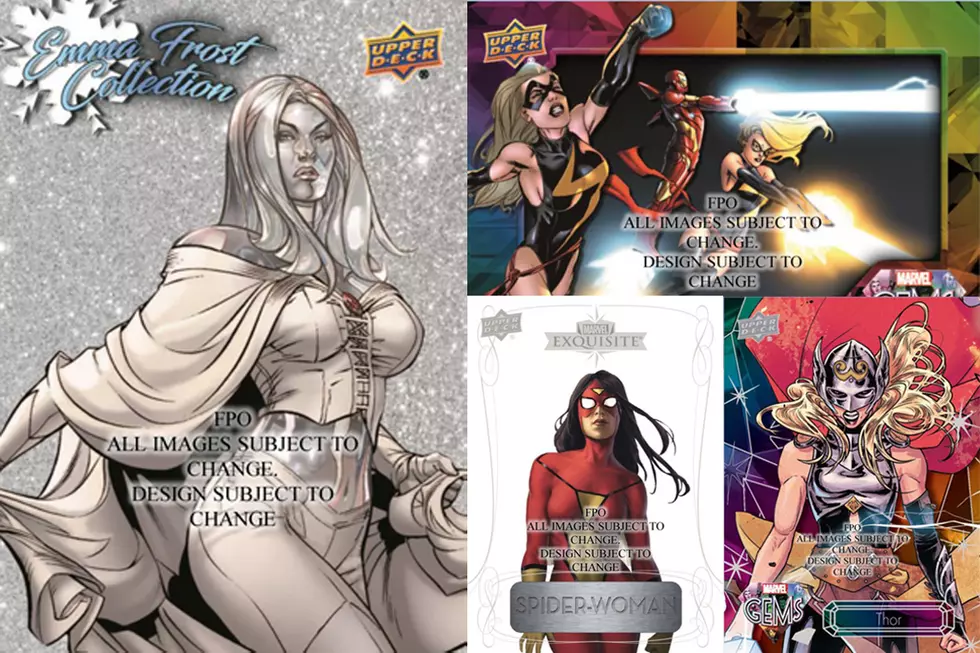![Joe Jusko and the Making of a (Marvel) Masterpiece [Interview]](http://townsquare.media/site/622/files/2016/06/11Fpg7_CapAMvsIronman.jpg?w=980&q=75)
Joe Jusko and the Making of a (Marvel) Masterpiece [Interview]
It's been years in the making, but the return of Marvel Masterpieces trading cards is nearly finally here. A callback to the Skybox series of fully painted cards originally released in 1992, the 2016 iteration from Upper Deck brings back the original artist Joe Jusko for a completely new set of cards and paintings. With more than 130 new pieces, all crafted by Jusko himself over the course of the last three years, it's no wonder it's taken some time for the set to see the light of day. The release schedule sliding out of 2014 ended up being a blessing though, as it gave Joe Jusko ample time to leave it all on the canvas. It certainly beats the 90 days he had to paint the original set in the early '90s.
We've been looking forward to this set since Upper Deck rescheduled it earlier this year for release this June. The first Marvel Masterpieces series is of the most celebrated comic book trading card sets of all time, and seeing it return after all these years is more than just a nostalgia trip. It's a chance to reconnect with one of comics' greatest artists on a scale otherwise impossible. You'd likely never be able to afford 135 paintings from Joe Jusko, but thanks to Upper Deck, that kind of dream is fairly close to reality.
We had a chance to speak with Joe Jusko about returning to the Marvel Masterpieces brand after all these years, and what to expect from the upcoming card set. We've also got an exclusive look at some of the cards you'll find in packs starting this week.
ComicsAlliance: It's been almost 25 years since the very first Marvel Masterpieces trading card series. What was it about this project that made you want to return?
Joe Jusko: I’ve been toying with the idea of revisiting this franchise for the past 20 years. I’ve always found it a bit ironic that while it’s the project I’m best known for and the property I’m most associated with, it’s the one that I had the overall least amount of time to complete. As time went on and other sets were done by other artists who had a lot more time than I originally did (I painted the ’92 set in just over 90 days), I got more and more self conscious about how unfinished a lot of the pieces looked to me in comparison, especially when they were blown up for usages other that the cards. While they have taken on an almost legendary status in the trading card world --- I still sign more of them than anything else I’ve ever done --- I’ve always known that they weren’t the best I could have done because of the accelerated schedule.
CA: Like the original run, you're providing all the art for the base set, as well as a number of special inserts. What are some of the challenges of undertaking creation of a trading card set like this basically entirely on your own?
JJ: I’ve done several full card sets to date. Obviously, the sheer volume of work is the biggest concern. Aside from actually painting the cards, you first have to come up with the concepts and draw them out, wait for approvals, etc. Being a traditional artist, the process is also inherently slower than working digitally. The other real concern is making sure not to repeat yourself in either ideas or color schemes. It’s very easy when you get on a roll to slide into autopilot. I tried as much as possible to put the characters in compositions or situations that were relevant to them rather than generic action shots, sometimes referencing the characters histories.
The palettes were just as important. While repeating color combinations may not be noticeable on a per piece basis, it becomes very evident when you place the cards side by side or in a binder page. After I got through the first half of the set this became a factor. I actually had to think and rethink these issues on a per card basis. Overall, I think I was pretty successful in handling these problems.
CA: In regard to the art itself, you obviously aren't painting these at scale. How large are you working before these are shrunken down, and do the smaller cards still manage to keep all the detail of your original works?
JJ: I painted the 92 cards at 6”x8.5” mainly due to the schedule and the fact that they were going to be shot down to card size (2.5”x3.5”). I didn’t see a reason to paint them any larger. I had seen the art for Jim Lee’s X-Men cards set and I believe it was around 5”x7”. When I saw my art later blown up for other uses, including the four volume comic collection, I realized that while the paintings made great cards, they didn’t hold up in the larger formats.They were just painted too loosely in many instances, and in a mixed media technique that fell apart when enlarged.
All my subsequent card art was painted completely in acrylics at 9”x12” in anticipation of it eventually being reproduced in book form. While still small, it did give me a lot more room to work, comparatively. You can’t work much larger and expect to get all that work done. In addition, all the extra detail a full-sized painting would allow would ultimately get lost when shot down. You have to consider how the art itself will ultimately be viewed when deciding at what size to work.
CA: Were you given free rein on who could be included in the set? If so, how did you decide which characters you wanted to include, outside of the obvious big stars at Marvel?
JJ: Having grown up reading Marvel books and then working for them since 1978, I’m pretty well versed in most of their history. I knew that all the mainstays would be included, but I didn’t want to paint the same set as the '92. There were a lot of secondary characters that I’ve had a soft spot for since childhood that I never had the opportunity to paint, so I sent Upper Deck a wish list. I was fortunate enough to get 60-70% of the list approved; characters like Hela, Tiger Shark, Ka-Zar and a few Kirby pre-hero monsters! Can you believe I’d never painted Ka-Zar & Zabu before?
All that said, I found I was not completely up to date on some of the more recent costume changes. When that issue reared its head Upper Deck either sent me what I needed or someone on Facebook got me what I needed in minutes. It was amazing.
CA: The new Marvel Masterpieces set has been in development for a few years now to allow you the time to work on all the art. In that time did you stick to all your original guns, or did you feel the need to tinker with some of the earlier works as you got farther along?
JJ: I’ve never been one to revisit a piece once it’s done. I put the best I can into it and it’s there for posterity. There is always another painting in the chute, but especially on a job like this that would be totally counterproductive because 1) The art was being approved by Marvel as the pieces were being completed. Redoing anything would have meant a new approval process, and 2) That would have compromised the project even more than the actually work already had.
Your style or approach doesn’t change in the middle of a project, but just to camouflage any inconsistencies the cards were not painted in any particular order. I jumped around the checklist as the character ideas came to me, so card #2 may very well have been the very last card I painted. With that said, these are 135 cover quality paintings. I pulled out all the stops on them.
CA: What have been some of your favorite characters to work on for this set outside of the big names like Captain America, Spider-Man or Hulk?
JJ: I really enjoyed the characters I hadn’t painted before. They kept me alert and sparked me creatively. There were a few major heroes and villains that had three and four cards, and that can try your enthusiasm after a while.
CA: Will we see any homages to your original Marvel Masterpieces in this new series?
JJ: Not from me. I tried as much as possible not to repeat anything I did on the '92 set. I wanted this to be a “stand on its own” collection. I think I’ve succeeded in surpassing my original set, which was my ultimate goal. I hope others feel the same way.
I do believe the sketch card theme for the set has artists doing homages and reinterpretations of my past work, though.
The Upper Deck Marvel Masterpieces 2016 card set will be available online and at hobby shops starting June 29. One box includes 12 packs of three cards, with one base card and two inserts guaranteed per pack. The base set consists of 90 cards with 10 short prints. Each box should also feature at least one sketch card (1:12 packs), one 1992 Marvel Masterpieces buyback (1:12 packs). Joe Jusko signed cards are expected to fall one in every four boxes.
More From ComicsAlliance


![Marvel Masterpieces’ Return Puts a Miniature Art Gallery in Your Hands [Review]](http://townsquare.media/site/622/files/2016/07/marvel-masterpieces-review.jpg?w=980&q=75)

![‘Secret Wars’ Too: Marvel Unveils Its Big Event For 2015, From Hickman And Ribic [NYCC]](http://townsquare.media/site/622/files/2014/10/marvel-secretwars-hed.jpg?w=980&q=75)




